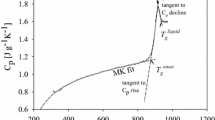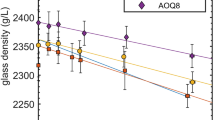Abstract
We conducted melting experiments on a low-alkali tholeiite (SiO2 ~52 wt%, MgO ~6.5 wt%, CaO/Na2O~4.4, Al2O3/SiO2 ~0.33) under both H2O-undersaturated and H2O-saturated conditions to investigate the effect of H2O on the Ca–Na partitioning between plagioclase and melt. Experiments were performed in the temperature and pressure ranges of 1,000–1,300°C and 1–5 kbar, respectively, with varying H2O contents of 0–12wt%. Redox condition was 0–2 log unit above NNO (nickel–nickel oxide) buffer. Temperature-bulk H2O diagrams for the low-alkali tholeiite are constructed at 1, 2, and 5 kbar, and compositions of near-liquidus plagioclase and coexisting melt are determined. To exclude the effect of melt composition (CaO/Na2O and Al2O3/SiO2 ratios) on plagioclase composition and to reveal the effect of H2O on An (=100×Ca/(Ca+Na)) content and \(K_{D}^{{\rm Ca-Na}}\) (=(Ca/Na)pl/(Ca/Na)melt), we focused on the composition of near-liquidus plagioclases which crystallized from melts with nearly constant CaO/Na2O and Al2O3/SiO2 ratios. Our experimental results show that, at each experimental pressure, An content of the near-liquidus plagioclase and the K Ca-Na D almost linearly increases as H2O content in melt increases. Each of the An content and the \(K_{D}^{{\rm Ca-Na}}\) variations in a low-alkali tholeiitic system (CaO/Na2O~4.0–4.5, Al2O3/SiO2 ~0.27–0.33) can be described by one equation using temperature, pressure, and melt H2O content as parameters. An content and \(K_{D}^{{\rm Ca-Na}}\) of liquidus plagioclase increases with increasing melt H2O and with decreasing pressure, elucidating that nearly H2O-saturated conditions of 2–3 kbar is optimal for the crystallization of the most An-rich plagioclase (>An88). We suggest this pressure condition of 2–3 kbar, corresponding to depth of 7–11 km, plays an important role for the origin of An-rich plagioclase in H2O-rich low-alkali tholeiite. At pressures more than ca. 4 kbar, crystallization of liquidus Ca-rich clinopyroxene decreases the CaO/Na2O ratio of liquid, thus prohibiting the crystallization of high-An plagioclase from hydrous tholeiite.









Similar content being viewed by others
References
Akella J, Vaidya SN, Kennedy GC (1969) Melting of sodium chloride at pressures to 65 kbar. Phys Rev 185:1135–1140
A-Miyasaka M, Nakagawa M (2002) Origin of Anorthite and olivine phenocrysts in island-arc tholeiite: petrological study of 1940 and 1962 ejecta from Miyake-jima volcano, Izu-Mariana arc. J Volc Geotherm Res 117:263–283
Arakawa Y, Murakami H, Kimata M, Shimoda S (1992) Strontium isotope compositions of Anorthite and olivine phenocrysts in basaltic lavas and scorias of Miyakejima volcano, Japan. J Min Petr Econ Geol 87:226–39
Arculus RJ, Wills KJA (1980) The petrology of plutonic blocks and inclusions from the Lesser Antilles island arc. J Petrol 21:743–799
Avdeiko GP, Volynets ON, Antonov AYu, Tsvetkov AA (1991) Kurile island-arc volcanism: structural and petrological aspects. Techtonophys 199:271–287
Baker DR, Eggler DH (1987) Compositions of anhydrous and hydrous melts coexisting with plagioclase, augite, and olivine or low-Ca pyroxene from 1 atm to 8 kbar: application to the Aleutian volcanic center of Atka. Am Mineral 72:12–28
Beard JS, Borgia A (1989) Temporal variation of mineralogy and petrology in cognate gabbroic enclaves at Arenal volcano, Costa Rica. Contrib Mineral Petrol 103:110–122
Bloomer SH, Stern RJ, Fisk E, Geschwind CH (1989) Shoshoniitc volcanizm in the northern Mariana arc 1. Mineralogic and major and trace element characteristics. J Geophys Res 94:4469–4496
Chou I-M (1987) Oxygen buffer and hydrogen sensor techniques at elevated pressures and temperature. In: Barnes HL, Ulmer GC (ed) Hydrothermal experimental techniques. John Wiley, New York, pp 61–99
Chou I-M, Cygan GL (1990) Quantitative redox control and measurement in hydrothermal experiments. In: Spencer RJ and Chou I-M (ed) Fluid-mineral interaction: a tribute to H. P. Eugster. The Geochemi Soc, Special Pub No. 2:3–15
Danyushevsky LV (2001) The effect of small amounts of H2O on crystallization of mid-ocean ridge and backarc basin magmas. J Volc Geotherm Res 110:265–280
Danyushevsky LV, Carroll MR, Falloon TJ (1997) Origin of high-An plagioclase in Tongan high-Ca boninites: implications for plagioclase-melt equilibria at low P(H2O). Can Mineral 35:313–326
Devine JD, Gardner JE, Brack HP, Layne GD, Rutherford MJ (1995) Comparison of microanalytical methods for estimating H2O contents of silicic volcanic glasses. Amer Mineral 80:319–328
Duncan RA, Green DH (1987) The genesis of refractory melts in the formation of oceanic crust. Contrib Mineral Petrol 96:326–342
Gerbe MC, Gourgaud A, Sigmarsson O, Harmon RS, Joron JL, Provost A (1992) Mineralogical and geochemical evolution of the 1982–1983 Galunggung eruption (Indonesia). Bull Volc 54:284–298
Gill J, Whelan P (1989) Early rifting of an oceanic island arc (Fiji) produced shoshonitic to tholeiitic basalts. J Geophys Res 94:4561–4578
Hasenaka T, Carmichael ISE (1987) The cinder cones of Michoacan-Guanajuato, central Mexico: petrology and chemistry. J Petrol 28:241–269
Housh TB, Luhr JF (1991) Plagioclase-melt equilibria in hydrous systems. Am Mineral 76:477–492
Ishikawa T, Nakamura E (1994) Origin of the slab component in arc lavas from across-arc variation of B and Pb isotopes. Nature 370:205–208
Kawamoto T, Hirose K (1994) Au-Pd sample containers for melting experiments on iron and water bearing systems. Eur J Mineral 6:381–385
Kimata M, Nishida N, Shimizu M, Saito S, Matsui T, Arakawa Y (1995) Anorthite megacrysts from island arc basalt. Mineral Mag 59:1–14
Kuo L-C, Kirkpatrick RJ (1982) Pre-eruption history of phyric basalts from DSDP Legs 45 and 46: evidence from morphology and zoning patterns in plagioclase. Contrib Mineral Petrol 79:13–27
Kuritani T (1998) Boundary layer crystallization in a basaltic magma chamber: evidence from Rishiri Volcano, northern Japan. J Petrol 39:1619–1640
Longhi J, Fram MS, Auwera JV, Montieth JN (1993) Pressure effects, kinetics, and rheology of anorthositic and related magmas. American Mineralogist 78:1016–1030
Martel C, Pichavant M, Holtz F, Scaillet B, Bourdier J-L, Traineau H (1999) Effects of fO2 and H2O on andesite phase relations between 2 and 4 kbar. J Geophys Res 104:29453–29470
Metrich N, Rutherford MJ (1998) Low pressure crystallization paths of H2O-saturated basaltic-hawaiitic melts from Mt Etna: implications for open-system degassing of basaltic volcanoes. Geochim Cosmochim Acta 62:1195–1205
Mirwald PW, Kennedy GC (1979) The melting curve of gold, silver, and copper to 60-kbar pressure: a reinvestigation. J Geophys Res 84:6750–6756
Moore G, Carmichael ISE (1998) The hydrous phase equilibria (to 3 kbar) of an andesite and basaltic andesite from western Mexico: constrains on water content and conditions of phenocryst growth. Contrib Mineral Petrol 130:304–319
Moore G, Vennemann T, Carmichael ISE (1998) An empirical model for the solubility of H2O in magmas to 3 kilobars. Am Mineral 83:36–42
Nakagawa M (1987) Geology of Iwate volcanic group, northeastern Japan. J Mineral Petrol Econ Geol 82:132–150 (in Japanese with English abstract)
Nielsen CH, Sigurdsson H (1981) Quantitative methods for electron microprobe analysis of sodium in natural and synthetic glasses. Am Mineral 66:547–552
Onuma K (1962) Petrography and petrochemistry of the rocks from Iwate volcano, northeastern Japan. J Mineral Petrol Econ Geol 47:192–204
Panjasawatwong Y, Danyushevsky LV, Crawford AJ, Harris KL (1995) An experimental study of the effect of melt composition on plagioclase-melt equilibria at 5 and 10 kbar: inplications for the origin of magmatic high-An plagioclase. Contrib Mineral Petrol 118:420–432
Roggensack K, Hervig RL, Mcknight SB, Williams SN (1997) Explosive basaltic volcanism from Cerro Negro Volcano: Influence of volatiles on eruptive style. Science 277:1639–1642
Sato H (1989) Fe-Mg partitioning between plagioclase and liquid in basalts of Hole 504B, OPD LEG 111: a study of melting at 1 atm. Proc ODP Sci Res 111:17–26
Sato H, Nakada S, Fujii T, Nakamura M, Kamata S-K (1999) Groundmass pargasite in the 1991–1995 dacite of Unzen volcano: phase stability experiments and volcanological implications. J Volc Geotherm Res 89:197–212
Scaillet B, Evans BW (1999) The 15 June 1991 eruption of Mount Pinatubo. É. Phase equilibria and pre-eruption P-T-fO2-fH2O conditions of the dacite magma. J Petrol 40:381–411
Shibata T, Nakamura E (1997) Across-arc variations of isotopes and trace element compositions from Quaternary basaltic volcanic rocks in northeastern Japan: Implications for interaction between subducted oceanic slab and mantle wedge. J Geophys Res 102:8051–8064
Singer BS, Pearce TH, Kolisnik AM, Myers JD (1993) Plagioclase zoning in mid-Pleistocene lavas from the Seguam volcanic center, central Aleutian arc, Alaska. Am Mineral 78:143–157
Sisson TW, Bronto S (1998) Evidence for pressure-release melting beneath magmatic arcs from basalt at Galunggung, Indonesia. Nature 391:883–886
Sisson TW, Grove TL (1993a) Experimental investigations of the role of H2O in calc-alkaline differentiation and subduction zone magmatism. Contrib Mineral Petrol 113:143–166
Sisson TW, Grove TL (1993b) Temperatures and H2O contents of low-MgO high-alumina basalts. Contrib Mineral Petrol 113:167–184
Sisson TW, Layne GD (1993) H2O in basalt and basaltic andesite glass inclusions from four subduction-related volcanoes. Earth Planet Sci Lett 117:619–635
Sobolev AV, Chaussidon M (1996) H2O concentrations in primary melts supra-subduction zones and mid-ocean ridges: Implications for H2O storage and recycling in the mantle. Earth Planet Sci Lett 137:45–55
Sugawara T (1999) Experimental techniques to minimize Fe and Na losses in one atmosphere gas mixing furnace. J Mineral, Petrol Econo Geol 94:425–441
Sugawara T (2001) Ferric iron partitioning between plagioclase and silicate liquid: thermodynamics and petrological applications. Contrib Mineral Petrol 141:659–686
Tatsumi Y (1989) Migration of fluid phases and genesis of basalt magmas in subduction zones. J Geophys Res 94:4697–4707
Tsukui M, Hoshino K (2002) Magmatic differentiation of Hachijo-Nishiyama volcano, Izu Islands, Japan. Bull Volc Soc Japan 47:57–72 (in Japanese with English abstract)
Acknowledgements
This paper formed a part of D. Takagi’s Master thesis at Kobe University, Japan. We thank Dr. Toru Sugawara for valuable discussion and constructive review on an early version of the manuscript. Journal reviews of Prof. John Longhi and an anonymous reviewer, and editorial suggestions by Prof. Tim Grove were of much help to improve the contents of the paper. We are indebted to Profs. K. Uto, K. Suzuki-Kamata and all the members of Volcanology Group at Kobe University for constructive discussions and encouragement throughout this study. The technical assistance of Mr. K. Sangen during high-pressure experiments with piston cylinder and of N. Tomioka during the EPMA analyses are acknowledged. This work was financially supported in part by Grant-in-Aid for Scientific Research from the Japan Society for the Promotion of Science to H. Sato.
Author information
Authors and Affiliations
Corresponding author
Additional information
T.L. Grove
Rights and permissions
About this article
Cite this article
Takagi, D., Sato, H. & Nakagawa, M. Experimental study of a low-alkali tholeiite at 1–5 kbar: optimal condition for the crystallization of high-An plagioclase in hydrous arc tholeiite. Contrib Mineral Petrol 149, 527–540 (2005). https://doi.org/10.1007/s00410-005-0666-7
Received:
Accepted:
Published:
Issue Date:
DOI: https://doi.org/10.1007/s00410-005-0666-7




